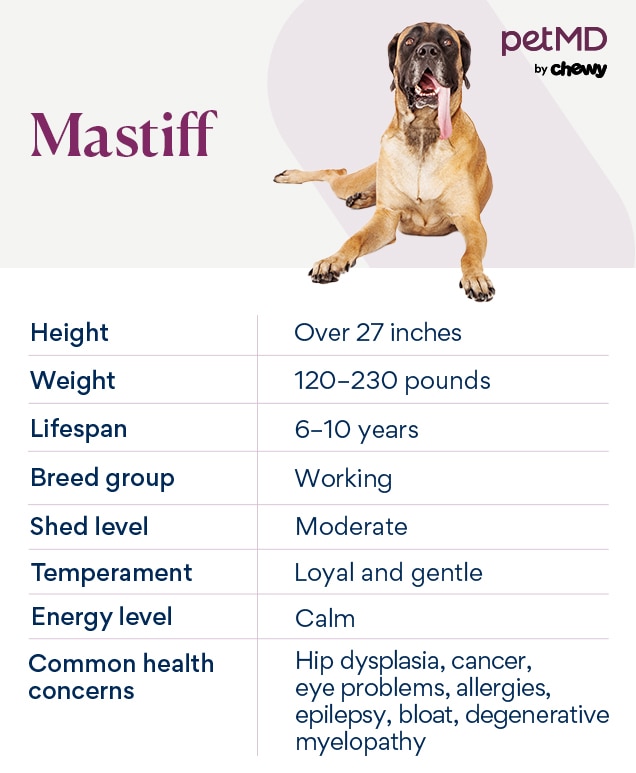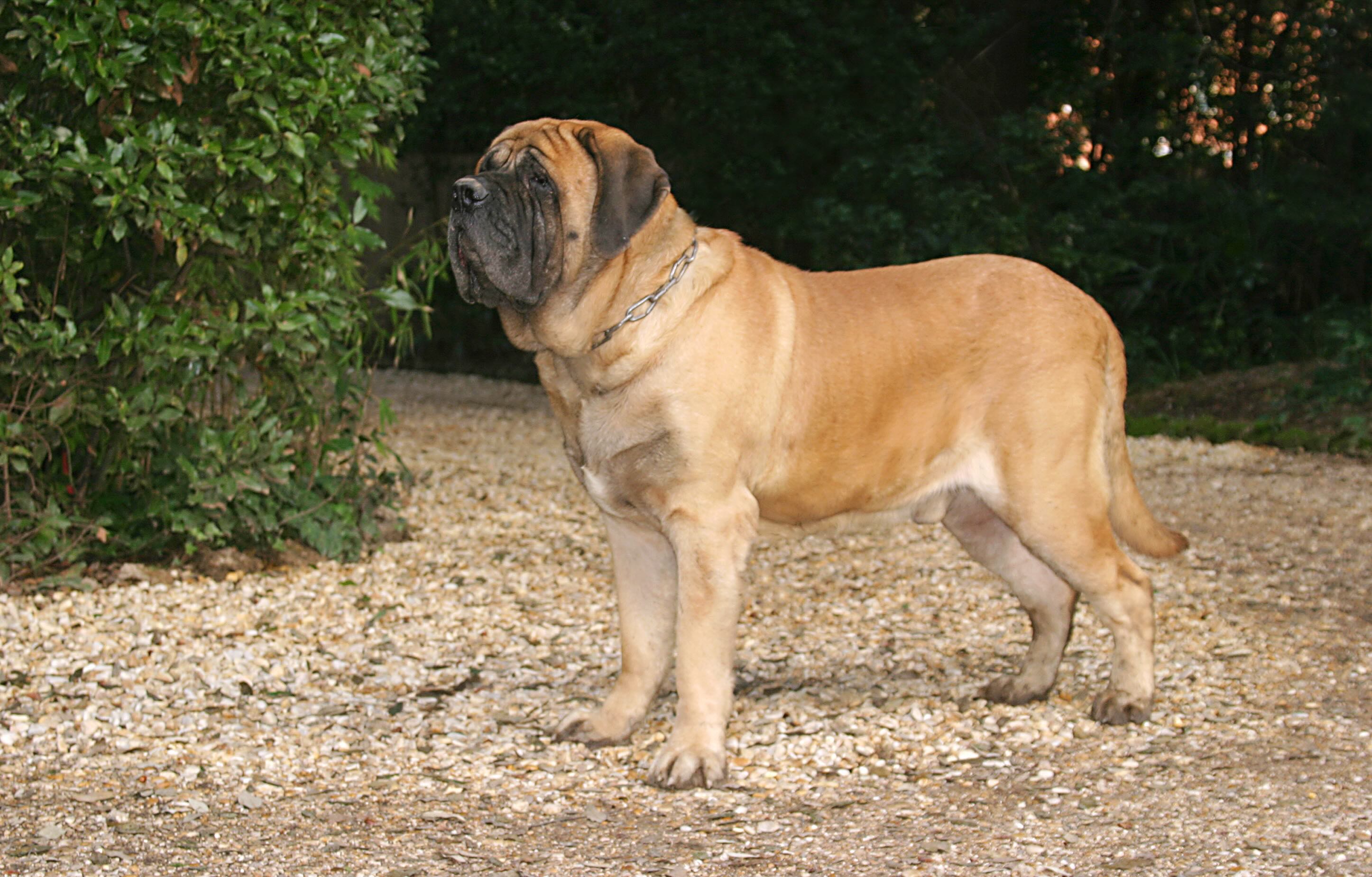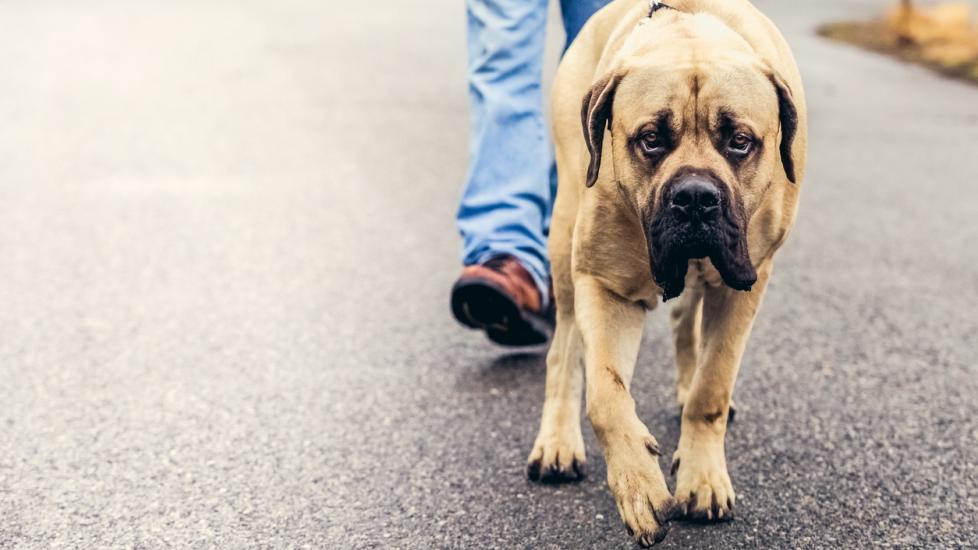Mastiff
iStock/debibishop
The massive Mastiff is an ancient dog breed with a rich history.
Also known as the Old English Mastiff, the breed was discovered in Britain when the Romans invaded in 55–54 BCE, though there’s evidence of Mastiff-like dogs dating back to 2500 BCE, according to The Mastiff Club of America (MCA). The dogs worked as hunters and guardians in Europe, and they eventually came to North America on the Mayflower.
All these years later, the Mastiff is still a popular giant dog. Adult Mastiffs stand 27.5 inches and up, with males commonly reaching 30 inches or more. A Mastiff’s weight is anywhere between 120 and 230 pounds, and they have a thick and well-muscled build.
The Mastiff’s historical role as a guardian has carried into the present, as the breed remains loyal to and watchful over their families. This, paired with their patient and lovable nature, makes a Mastiff a wonderful companion.
But bringing a giant-breed dog into a home is no small commitment, and early training and socialization is essential to have a well-mannered Mastiff.
Caring for a Mastiff

Though they might look formidable, the Mastiff’s broad, wrinkled head features kind and lovable expressions that pet parents adore.
When at home, most Mastiffs enjoy a couch potato lifestyle and tend to not have high energy needs. But don’t be fooled: If a someone new enters their home, they will instantly be on high alert. This is why socializing English Mastiff puppies is so important, so they can learn that new people aren’t something to be wary of.
Their short, dense, moderately shedding coats don’t require a lot of grooming. But Mastiffs are known to be excessive droolers, and pet parents need to keep a small towel handy for quick cleanups.
Mastiff Health Issues
Like other giant dogs, this breed generally has a shorter lifespan than small-breed dogs; the average Mastiff lifespan is just 6–10 years.
To help produce healthy Mastiff puppies, responsible breeders screen for the health conditions that commonly affect the breed. Investing in pet insurance might be a good idea for pet parents looking to bring home a Mastiff puppy.
Allergies
Similar to humans, cats and dogs can experience seasonal allergies triggered by environmental factors such as tree or grass pollen, dust, mold, and flea bites. These allergies often manifest as itchy skin or ear infections but can also cause runny and red eyes, a runny nose, or sneezing.
Many pets are diagnosed with seasonal allergies based on their clinical signs, physical exam findings, and response to therapy. For others with more severe allergies, diagnosis is done by a veterinary dermatologist who can perform allergy testing and develop patient-specific therapies.
Eye Anomalies
Mastiffs can be predisposed to eye disorders, such as:
-
Ectropion (when the eyelid rolls out away from the eye)
-
Entropion (when the eyelid grows inward)
-
Cataracts (clouding of the eye lens that can cause vision impairment)
-
Progressive retinal atrophy (an inherited disease that leads to vision loss)
In most cases of ectropion, entropion, and cataracts, veterinarians can diagnose and treat the dog with surgical intervention. PRA, however, cannot be treated, but it can be screened for with genetic testing.
Cancer
Mastiffs can be prone to developing cancer, specifically:
Cancers in dogs may present differently, from limping or lameness to a small growth on the skin. It’s important for a vet to evaluate any Mastiff dog showing signs of abnormal behavior or growths.
Hip Dysplasia
Hip dysplasia is when the bones of the hip joints do not align appropriately. This causes rubbing and grinding of the bones that, over time, results in deterioration of the joint and osteoarthritis.
Hip dysplasia can be a hereditary condition for Mastiffs, but it can also be exacerbated by other factors such as exercise habits, weight, and nutrition.
This condition can be screened for with X-rays, and treatment will vary depending on the condition’s severity.
Degenerative Myelopathy
Degenerative myelopathy (DM) is a progressive disease that causes hind limb weakness and paralysis due to degeneration of the spinal cord. The exact cause of DM is unknown, but some dogs carrying a certain genetic mutation seem to be prone to developing the disease.
Signs of DM commonly start in middle-aged dogs with “knuckling” or hind-end weakness, which can look like swaying when standing still, or easily falling over or stumbling. Over time, this progresses to the inability to use the hind legs to stand or walk.
Currently, there are no effective treatments for DM. Regular exercise and physical therapy have been shown to help in preserving muscle mass and quality of life for dogs with DM.
Epilepsy
Epilepsy describes recurrent seizures without a known cause. The appearance of a seizure can vary widely—some affect only a small part of the body, while others affect the entire body. Mastiff pet parents need to be aware of signs of a seizure in dogs, including:
-
Stiffening and falling over with shaking and vocalization
-
Paddling of the limbs
-
Loss of bladder and bowels
-
Drooling
-
Vomiting
Seizures can last a few seconds to a few minutes while the dog is unaware of what is going on around them. Before and after the seizure, the pet may act abnormally as well, appearing anxious or confused, disoriented, or sleepy.
Treatment is typically done with lifelong medications. But there’s good news: Once anti-seizure medication treatment begins, most pets live a fairly normal life.
Gastric Dilatation and Volvulus
Gastric dilatation and volvulus (GDV) is a severe form of bloat in dogs that can affect any deep-chested breed—including the Mastiff.
This happens when there’s a large amount of food and gas in the stomach, such as after a big meal. This buildup makes the stomach expand and prevents normal abdominal blood flow. The decreased blood flow causes a loss of blood to the stomach and, when combined with the high pressure from within, can lead to rupture.
To prevent GDC and bloat, many deep-chested dogs undergo a prophylactic stomach tacking (gastropexy) surgery to help prevent GDV, typically during their spay or neuter procedure.
Even with this precaution in place, it’s important to know when your English Mastiff may be showing signs of GDV. Seek immediate veterinary care if you notice these signs:
-
Distended abdomen
-
Retching without producing any vomit
-
General signs of abdominal pain, such as standing and stretching or drooling
-
Collapse
What To Feed a Mastiff

Selecting the best dog food for your Mastiff comes down to the needs of the individual dog. Discuss your dog’s diet with your veterinarian, as they can make recommendations based on your pup’s specific medical history.
In general, Mastiffs do well on a dog food that:
-
Meets Association of American Feed Control Officials (AAFCO) standards
-
Is formulated for large dog breeds
-
Is made for your dog’s current life stage (puppy, adult, or senior)
Mastiff puppies should be fed a large-breed puppy food, then switch to an adult formula once they reach 18–24 months age.
Talk to your veterinarian, who can help you choose the best food for your dog.
How To Feed a Mastiff
Mastiffs are deep-chested dogs, which means care must be taken to prevent gastric dilatation and volvulus (GDV) or bloat. Pet parents should:
-
Feed their Mastiff two to three meals per day, instead of one big meal
-
Restrict exercise for an hour before and after mealtimes
-
Avoid elevated dog food bowls
How Much Should You Feed a Mastiff?
The amount you feed your dog depends on the individual Mastiff, and it’s always best to talk with a veterinarian about your dog’s diet and nutritional needs. That said, Mastiffs need a lot of food because of their massive size, so budget accordingly.
Nutritional Tips for Mastiffs
For Mastiffs that have growth disorders affecting their joints, such as hip dysplasia, it can be beneficial to give them joint supplements with glucosamine and chondroitin to help keep their joints healthy.
Omega-3 supplements also aid in protecting joint health, and keep their skin and coat healthy, too.
Always talk to your veterinarian before adding anything new to your dog’s diet, including supplements.
Behavior and Training Tips for Mastiffs
Mastiff Personality and Temperament
In the home, Mastiffs are generally patient and calm dogs, but they spring into action as soon as they perceive a threat—even if it’s just the mail carrier walking by.
Their gentle demeanor makes them suitable for families with children who understand how to interact with dogs, but Mastiffs may be best in homes without younger children, who may be easily knocked down by an accidental bump from these enormous dogs.
But overall, Mastiffs are gentle giants and tend to do well with other pets, especially when introduced during puppyhood.
Mastiff Behavior
Because they have been used as guardian dogs for centuries, Mastiffs can be instinctually reserved around strangers. Pet parents need to invest in early training and socialization as soon as they bring home their Mastiff puppy.
Despite their suspicions toward new people, Mastiffs don’t bark a lot, and they’re gentle with humans and animals they know.
Mastiff Training
Mastiffs are eager to please, learn quickly, and respond well to positive reinforcement methods that make training fun. However, training sessions are best kept short to keep their attention and focus.
Don’t hesitate to reach out to a certified dog trainer if you need help teaching your Mastiff the basics.
Fun Activities for Mastiffs
-
Pulling carts
-
Obedience
-
Tracking
-
Lounging on the couch
Mastiff Grooming Guide

When it comes to upkeep, a Mastiff’s short coat is pretty low-maintenance. The most effort will probably go toward managing their drool, which seems to flow endlessly from their droopy jowls.
Pet parents find it helpful to always have a cloth at the ready to wipe their Mastiff’s face … and wipe off any drool that finds its way to the floor, walls, and furniture.
Skin Care
If those adorable facial folds and jowls aren’t kept clean, Mastiffs can develop skin infections. Pet parents need to wipe their Mastiff’s facial folds daily with a pet-safe facial wipe or damp paper towel to prevent buildup of moisture and debris.
Coat Care
English Mastiffs have a short, dense coat and are moderate shedders. Weekly brushing with a grooming mitt or bristle brush reduces shedding, but bathing your dog is only really necessary every few months.
Mastiffs may experience periods of heavy shedding once or twice a year. During these periods, they need to be brushed more frequently.
Eye Care
Mastiffs are prone to numerous eye conditions, so pet parents need to monitor their eyes and contact a vet if any changes are noticed. Along with regular monitoring, a Mastiff’s eyes need to be cleaned routinely to help prevent tear stains and infections.
Ear Care
Routine ear cleaning with a veterinary-approved ear cleanser is important for keeping your Mastiff’s ear canals healthy. Their ears must be cleaned after they’re in water, such as after a bath or after swimming.
Considerations for Pet Parents
Their generally lazy lifestyle makes the Mastiff a lovable companion. They are gentle and affectionate toward their families, but early socialization is vital to help prevent the protective behaviors for which English Mastiffs have been bred for thousands of years.
Well-trained, well-socialized Mastiffs are truly gentle giants and do well with other animals as well as children. But these pups are sometimes unaware of their giant size, which can be problematic for smaller animals and young children.
Before bringing home a Mastiff puppy, consider your space and budget. Mastiffs need lots of room to exist comfortably; you probably don’t want to be navigating around one in a 500-square-foot apartment. Big dogs like Mastiffs also require much more food than smaller breeds, and that comes at a significant cost.
Mastiff FAQs
How long do Mastiffs live?
The average Mastiff lifespan is 6–10 years.
How much do Mastiffs weigh?
Female Mastiffs typically weigh 120–170 pounds, and it’s not uncommon for males to exceed 200 pounds. According to the MCA, the largest Mastiff on record was a male named Zorba, who weighed a whopping 343 pounds.
Are Mastiffs good family dogs?
Yes, Mastiffs are great family dogs, and their calm nature is suitable for homes with children who understand how to appropriately interact with pets.
However, they may be best suited in homes without toddlers or babies, as their massive size can be dangerous. All interactions with children and dogs of any breed should be supervised.
Which is bigger, a Mastiff or a Bullmastiff?
Bullmastiffs are related to Mastiffs, but they are a separate breed that was created by crossing Mastiffs with Bulldogs. Because of this, Bullmastiffs are smaller than Mastiffs. While Mastiffs can weigh 120–230 pounds, Bullmastiffs typically weigh 100–130 pounds.
